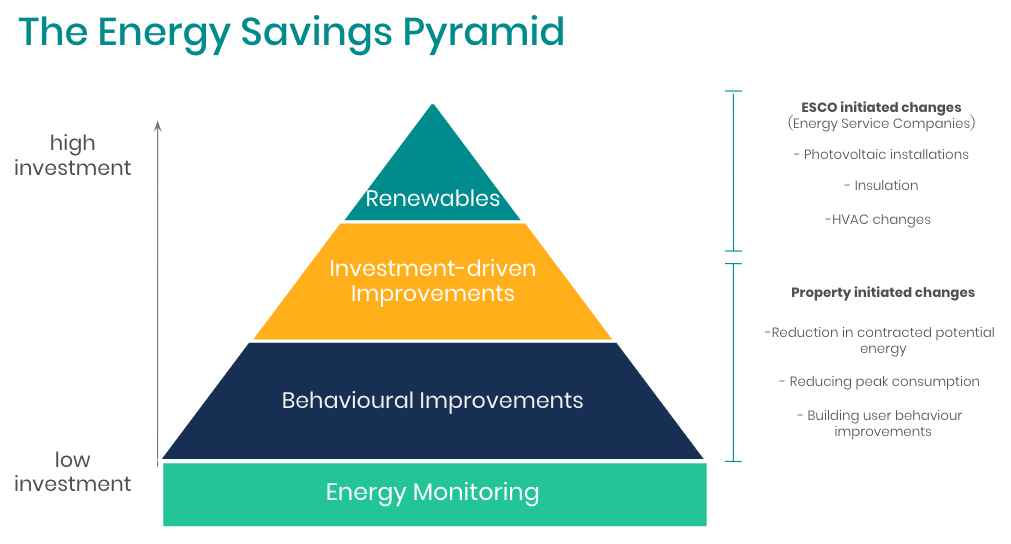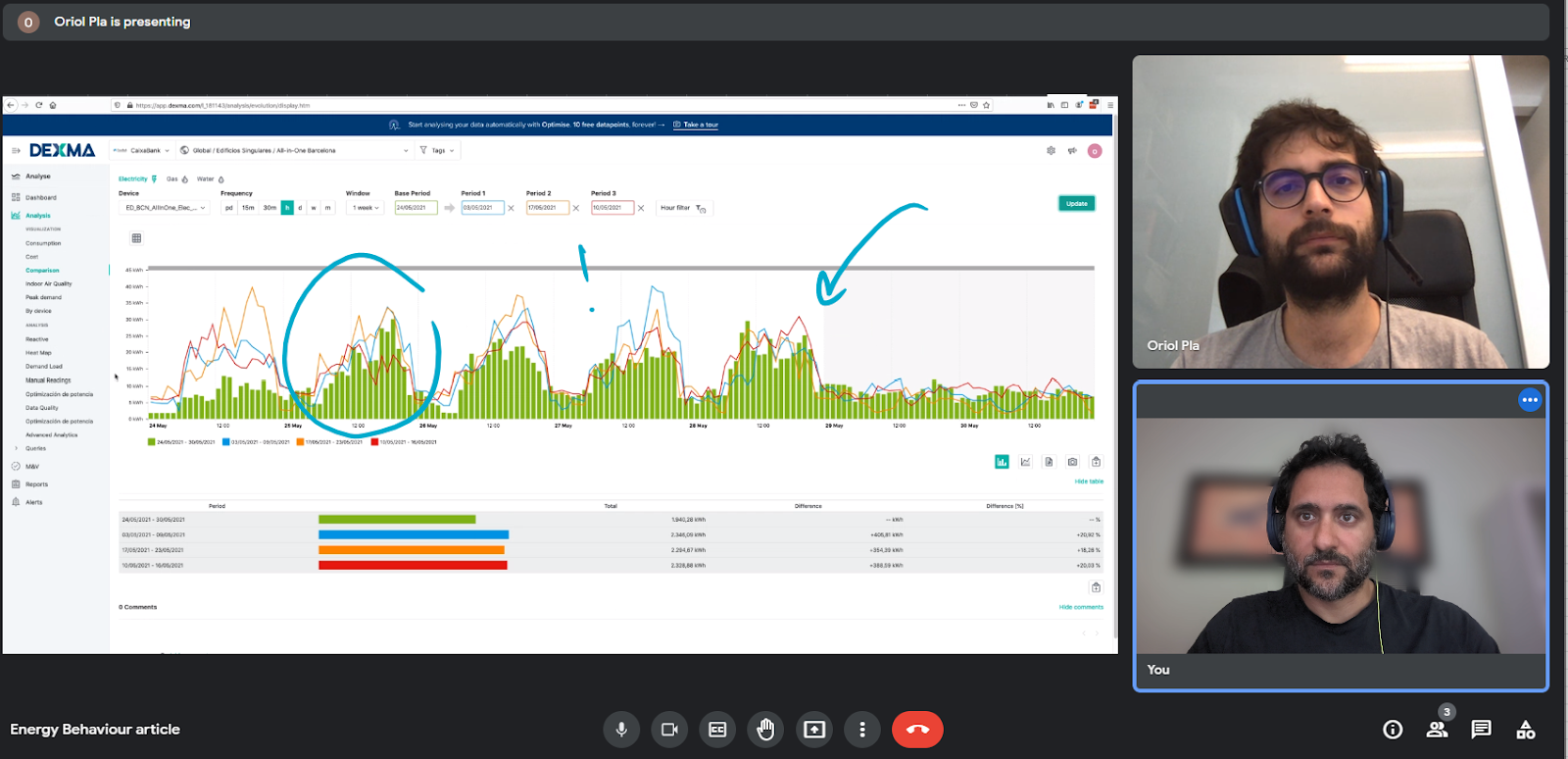If I ask you about the energy culture in your organisation, how would you define it? In other words, could you define the habits, rules and resources aimed at promoting and implementing habits that ensure the efficient use of energy?
This is what this article is about, how to change the energy culture of your company and improve the behaviour of the users of your buildings.
In a world that aims for the decarbonisation of the economy, energy consumption in buildings is one of the main sources of carbon dioxide emissions. In order to reduce these emissions and bring buildings closer to carbon neutrality (or even become carbon sinks), their energy efficiency must be drastically increased. And, we must bear in mind that the EU has an energy efficiency target to reduce its primary energy consumption by 32.5% by 2030 and, according to 2019 data, the EU’s primary energy consumption is 19.8% over the target.
Historically, companies that planned to reduce their energy consumption (or their customers’) performed energy audits and identified and prioritised the retrofits to reduce energy consumption by the replacement or installation of new equipment – that is, the focus was mainly on improving existing technology in the building.
To increase the success of these retrofits it is necessary to improve the energy culture of the building users, meaning the previous beliefs, norms and technical knowledge of the targeted individual or group. In this way, when building users have experienced a shift in their energy culture, implemented retrofits are much more effective, efficient and durable.
Nowadays, this approach has shifted to address the energy culture of building users, focusing on triggering an energy behaviour change among building users, which then generates energy and economic savings to finance improvements in equipment (HVAC, lighting, BMS, domotics, etc.) or in the building envelope (insulation, window refurbishment, etc).
The savings generated by the second phase of retrofits also can be used to finance energy self-production equipment, such as PV panels, bringing the building closer to carbon neutrality.
Energy culture change brings benefits to energy consumers, as it directly impacts their own economy, for Utilities and Energy Services Companies (ESCOs). As a result, the organisation can use energy behaviour change to improve their engagement with customers, to upsell their energy services and/or retrofits and eventually reduce their churn rate.
Benefits are also tangible for financial institutions, which profit from the economic savings caused by behavioural changes to finance retrofitting products to their customers.
Plus, while reducing operating costs, companies with large building portfolios can include energy culture change in their CSR strategy and boost team-building skills among their employees.
The development of energy behaviour change applications and AI-based tools for energy management – together with local and regional policies for energy efficiency – are fostering the adoption of energy behaviour change initiatives for both residential and tertiary buildings.
On the other hand, the smart meter rollout across the EU has incentivised the adoption of dynamic tariffs for tertiary and residential consumers, who are now more focused on demand-side management techniques, such as shifting loads to the cheapest periods. This, in turn, gives relevance to the energy manager’s role, which becomes critical to reduce the operating costs of buildings.
Remember that the democratisation of technologies like the electric vehicle, on-site renewable production (PV, thermosolar, mini eolic), microgrids and storage batteries also require an energy culture shift to operate optimally.
And finally, the Covid-19 pandemic has also raised energy awareness, as remote workers have seen their electricity bills increase and many companies have had to analyse their operating costs to adapt to the new normality. Consequently, this new normality entails more teleconferencing, which is an opportunity to share graphic energy management insights and best practices.
These factors increase the motivation of consumers to improve their energy practices and engage with the measures that energy managers propose. In addition, many companies are going for a hybrid office policy with enhanced ventilation and Indoor Air Quality monitoring, which usually results in increased energy consumption.
Improving the energy behaviour of building users is a way to give visibility and to value the work of Energy and Facility Managers, motivating them to engage users in good energy habits and practices and increase their commitment to energy efficiency.
From the point of view of these professionals, energy behaviour change projects pose several challenges that you can check below.
3 Energy Professional Challenges in Energy Behaviour Change Projects
1. How can you identify the sites and loads with the biggest savings potential?
As an Energy or Facility Manager managing a big building portfolio, knowing which locations will profit most from changes in the energy behaviour of its users is key.
With this in mind, it is good to have a tool that gives you support and helps you to segment your building portfolio. This is the case of Spacewell Energy Detect, a virtual energy audit tool that classifies the sites according to their energy-saving potential by comparing energy consumptions, weather data and location metadata.
If you would like to know which are the main loads in each of your locations, Detect also provides you with disaggregated monthly consumptions for each location.
Now it is up to you to decide which locations will participate in your campaign for energy culture change!
2. How can you assess the impact of the energy behaviour changes?
Another key aspect that determines the success of energy behaviour change initiatives is to know what impact it is having on energy consumption. To find out, you should do an advanced analysis.
Tools such as Spacewell Energy Analyse assist you in the setting up and tracking of savings goals with its M&V feature and in the real-time monitoring of actions with its Consumption and Cost sections – the latter also allows you to visualise the energy cost per tariff period.
You can also compare the consumption with previous periods in the Evolution section. Determining the impact of energy culture change has never been that easy!
3. Is there a way to ensure that your energy culture changes are long-lasting? Can you detect any deviations?
This is a big one – the real success of behaviour changes is when they last and there are no rebound effects. To solve this challenge, you can work with tools based on machine learning algorithms as Spacewell Energy Optimise. This tool allows you to detect any deviation from the path of efficiency, whether it is a change in energy behaviour or in your building operation or equipment.
In fact, Spacewell Energy (Dexma) Partners have already benefited from energy behaviour initiatives in the past.
For instance, in 2010, UPC (Universitat Politècnica de Catalunya), started monitoring the consumption of one of the biggest libraries in Catalonia with Spacewell Energy (Dexma) and a team of UPC students began a project of energy conservation mainly based on a behaviour change strategy.
As an anecdote, the first steps of this project were not easy because of the opposition of the library chief, who didn’t understand what exactly was an energy behaviour change. After a few months of interactions, he suddenly changed his vision and became the project leader: he understood that energy savings could be a team project and a perfect way to project a modern image of the organisation.
The energy culture of his team changed under his leadership, and after 3 years, they managed to save 43% of their electric energy consumption (€42.000 per year). In addition, these savings gave the chance to:
- expand the initiative to 90 UPC buildings,
- achieve 4M€ savings in 4 years,
This saving of 4M€ allowed, consequently, the UPC upwards the efficiency pyramid: it provided enough resources to implement investments in retrofitting equipment (substitution to LED technology, substitution of boilers and chillers), domotics improvement and energy certification.
Eventually, the improvements in the overall energy efficiency of the university have generated enough savings to invest in solar photovoltaic installations in most campuses, with more than 600kW projected and/or installed and several geothermal, aero-thermal and biomass projected installations.
In sum, the UPC has experienced a 23% energy reduction in 2020 compared to 2007, which is taking into account that during 2016-17 a new campus that represented about 12% of the UPC’s energy consumption became operational.
How can Spacewell Energy (Dexma) help you Change the Energy Culture of your Building Users?
We know that to change the energy culture of consumers and building users there may be challenges. That is why the Spacewell Energy (Dexma) Platform provides tools for energy management that are visually stimulating and provide the user with an experience similar to gaming.
For example, the tools and apps that you can use inside this energy platform will give you locations’ best and worst rankings according to their energy-saving potential. Moreover, saving goals can be tracked in real-time and models can be trained by the user in order to automate the detection of any anomalies in the energy performance of monitored buildings.
Thanks to these tools, Energy and Facility Managers can learn, estimate impacts for their actions and improve building energy performance. All of this combined is an intrinsic motivation for the user, instead of a complete gaming experience with obvious external rewards, which the user may feel is patronising and infantilising.
At the same time, Spacewell Energy (Dexma) has had the opportunity to learn from other experiences it has had with energy behaviour change, such as its participation in the EU-funded FEEdBACk project. This European project aimed to assess energy behaviour change in tertiary and residential buildings, through a gamified application integrated with Spacewell Energy (Dexma) Analyse and ad hoc energy management algorithms (load disaggregation, occupancy forecasting, and netload forecasting among other tools).
Another example where Spacewell Energy (Dexma)’s energy management team has used its software to change the energy culture is in one of the biggest Spanish banking company’s buildings and branches.
In conclusion, the actual context is idyllic for energy culture change, as several social, legal and technological factors mark it as the most favourable time.
Thus, energy culture change brings benefits to all players in the energy market – from utilities to consumers.
In particular, it is a chance to give value and visibility to energy management professionals, who have in Spacewell Energy (Dexma) an ideal, visual and pseudo-gamified set of tools to detect which locations have more energy-saving potential, track energy behavioural campaigns and make sure that they persist in time.
So now that you know more, it’s time to accelerate the changes in your company’s energy culture by relying on tools such as the Spacewell Energy (Dexma) integrated platform. Enter the Free DEMO here!
Editor’s note – This article has been written by 2 of our experts in advanced energy analytics and energy performance at Spacewell Energy (Dexma):


![[Energy Behaviour] How to change the Energy Culture of your Building Users](https://www.dexma.com/wp-content/uploads/2021/06/Energy-Behaviour-How-to-change-the-Energy-Culture-of-your-Building-Users-1-1400x788.png)





